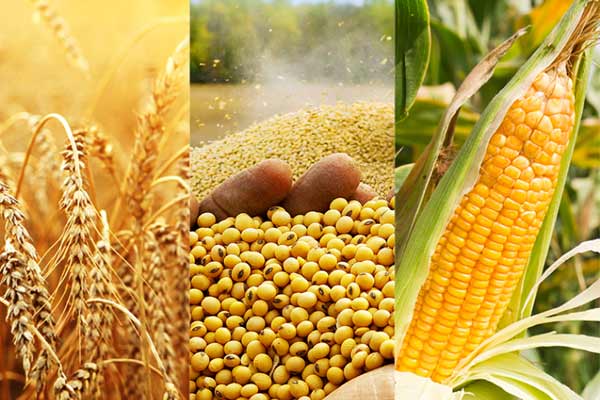Small Farms and India’s Agriculture Export Policy
• Government of India has announced first comprehensive agriculture export policy which has aim of doubling India’s agriculture exports and doubling the farmers income.
• Inspite of having huge potential, India’s share in the world agri-export market is not considerable.
• It is very important to have active export clusters at district level in order to tap the export potential of small and marginal farmers.
• There are successful clusters in India such as Gujarat Cooperative Milk Marketing Federation (branded Amul), grape cluster in Maharashtra (mahagrapes), etc where small and marginal farmers are getting great benefits.

India is an emerging economic power and in this transition, agriculture has to contribute a lot. In fact, the base of the Indian economy is agriculture – almost 60% people of this country are dependent on agriculture. Recently, the Government of India has announced the first comprehensive agriculture export policy, which has the aim of doubling the agriculture exports and doubling farmers incomes. In spite of having huge potential, India’s share in world agri-export market is not considerable. It demands strategic efforts to increase agriculture exports, as that will boost the agriculture economy.
According to the Agriculture Census, average land holding in India is 1.15 hectares per farmer. In India 85% farmers are in marginal and small farm categories of less than 2 hectares. In these circumstances, clustering is the only solution for promotion of exports by small and marginal farmers and bringing them in the chain of agribusiness.
Small farmers problems:
1. They have limited land and resources.
2. Their farm output is limited, due to which they can’t compete with big players in the market.
3. Domestic market is not organised hence market intelligence is not easily available to them.
4. Lack of input impact on productivity, which ultimately hampers price competitiveness.
Unless farmers are encouraged to do business, it won’t uplift their socio-economic status. Hence, efforts must be in the direction of farmers thinking beyond production.
Small holding farmers and export cluster:
Involvement of small and marginal farmers in the export basket is a highly challenging task because they have limited resources. However, without the involvement of 85 million small and marginal famers in export business, India’s agriculture export policy will not be successful. Agriculture export significantly influences farmers incomes because if there is export it does have an impact on the price of the same product in the domestic market too.
A single marginal farmer may not able to export, but with combined resources of a number of farmers, exports can happen. Therefore, It is very important to have an active export cluster at the district level in order to tap the export potential of small and marginal farmers; through this, they can have the benefits of an export business. Formation of an export cluster strengthens farmers by bringing common resources such as:
• Common facilities for pre-cooling, cooling and storage, reducing the cost of market linkage, transparent standards of quality, mutually-owned insurance etc, can be availed collectively.
• Brand building of product even at local level.
• FPO’s and co-operatives linked with the farmers and exporters.
• Reaching farmers at grass root level and strengthening the supply chain to avoid losses.
• Emphasis on processing and value addition.
• New start-ups in agri-exports at village level.
Benchmark Clusters Globally and Locally:
There are successful clusters in India such as Gujarat Cooperative Milk Marketing Federation (branded Amul), grape cluster in Maharashtra (mahagrapes),etc, where small and marginal farmers are getting great benefits. Even at the international level, clustering is successful; for the example France (wine), Japan (Kobe beef), Colombia (Juan Valdez coffee) and New Zealand (Manuka honey).
Clustering in India’s New Agriculture Export Policy
Product clustering is one of the important strategies in export promotion, hence unique export clusters have been identified in the agriculture export policy. Product wise and district wise clusters have been notified based on the existing production contributing to exports, exporters’ operations, size of export market, scalability etc. The products which have export potential include banana, pomegranate, mango, grapes, onions, potatoes, tea, coffee, marine products, chilli, turmeric, cumin, pepper, cardamom etc.
The major share of agricultural land is with the small and marginal farmers and this major portion itself is left out from the circle of agribusiness and exports. Operational export clusters at the grass root level can channelise this major farmer’s force through their active participation in the entire value chain of agribusiness and exports, which will eventually double farmers income and exports.

Dr. Parashram Jakappa Patil is currently an Advisor/Consultant at APEDA. He has also served as the President of The Institute for Natural Resources, Kolhapur. He is also an export policy consultant for the Ministry of Commerce and Industry. He has received many awards and accolades lately; some of which include Young Researcher Award, Best Citizen of India Award.













One of the best article on Agriculture
Thank you Dr. Patil Sir
I am very keen to look after the rural farmers interest in Agri products and its export and look for necessary guidance to its successful operation. I am from West Bengal and would be glad to see our farmers from rural West Bengal to join this expo
Dr Patil farmers income doubling by exporting the agricultural commodities is true .We Need change the farmers farm practices to increase yealds match the international prices and QC .Gov should put efforts on Farm Manage and technology
To engage 85 million smallholders in the export market one thing is absolutely required:
1) Understanding of compliance, contamination of crop due to mislabeled inputs, and mass adoption of good agricultural practice.
Sir
There is major gap between various departments of government in definition of agricultural product which is also creating problem in export
I would like to provide some information on this problem my contact number is 9372109990
9643719893, patilparashram9@gmail.com, I am open for discussion.